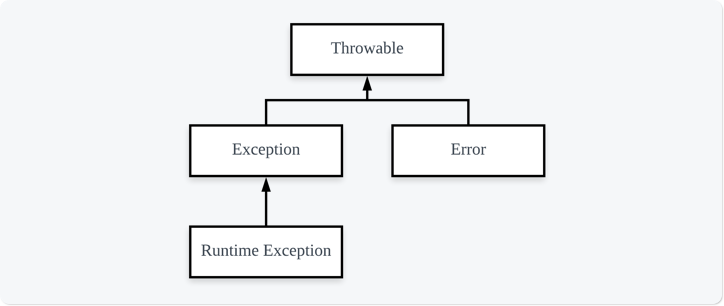一篇文章尽可能搞懂Java Exception
异常对大家来说是再熟悉不过的内容了,我们通常处理的线上问题是由各种异常引起的,我们通常在系统设计时要考虑各种异常场景,我们在日常编码中也要处理各种异常分支逻辑。
但是我们对异常的了解似乎又不那么深刻。我们听说过很多有关异常处理的 经验 ,但这些经验都是对的么?
什么是Exception
要了解异常,就不得不从Exception的继承关系着手,介绍Java Exception的文章网上有很多,这里就长话短说。Exception与Error都是Throwable的子类。

Exception又分为Checked/Unchecked,其中Checked Exception接受编译期检查,必须在代码层面进行显式的处理。而Unchecked Exception不需要显式处理,也就是通常情况下我们所谓的Runtime Exception,该类异常多数情况下是可以通过编码处理。
JVM如何处理Exception
通过上面简单的介绍,对于Exception的基本概念,相信大家至少有了一定了解。接下来我们看看JVM是如何处理Exception的。
首先,我们需要定义一个会抛异常的方法,和对应try/catch代码块对该异常方法的处理,具体代码如下所示:
public class OneExceptionService {
public void createSomeException() {
throw new IllegalArgumentException("Have some exception");
}
}
public class MiddleService {
private OneExceptionService oneExceptionService;
public void catchException() {
try {
oneExceptionService.createSomeException();
} catch (Exception e) {
throw new RuntimeException(e);
}
}
}
复制代码
对于我们接下来讲解的内容来说,上面的代码会显得繁琐,是因为我们后面还会继续用到这一组代码。接下来我们仅仅需要关注catchException方法对应字节码,如下所示:
public void catchException();
Code:
0: aload_0
1: getfield #2 // Field oneExceptionService:Lme/hergootian/exception/OneExceptionService;
4: invokevirtual #3 // Method me/hergootian/exception/OneExceptionService.createSomeException:()V
7: goto 20
10: astore_1
11: new #7 // class java/lang/RuntimeException
14: dup
15: aload_1
16: invokespecial #8 // Method java/lang/RuntimeException."<init>":(Ljava/lang/Throwable;)V
19: athrow
20: return
Exception table:
from to target type
0 7 10 Class java/lang/Exception
复制代码
在编译生成的字节码中,我们会看到下方有一个异常表(Exception table)。异常表中包含4个属性,from和to代表异常监控范围,target表示异常处理的开始,type表示异常处理所捕获的异常类型。这个异常表存储在Non-Heap空间上的PermGen/Metaspace区域。
那么当我们的程序出现异常的时候,JVM会如何处理这个异常表呢?
- 首先查找出现异常的方法对应异常表,如果当前方法异常表不为空,对异常表其中一个条目进行判断,异常是否发生在该条目from到to监控的代码行,同时type匹配,则JVM调用位于target指向的处理逻辑进行处理;
- 如果上述过程未找到符合条件的处理者,则继续查找异常表中的其他条目;
- 当遍历完整个方法的异常表仍未找到符合条件的处理者,则向上查找(弹栈);
- 查找当前方法的调用方法的异常表,重复上述1-3的逻辑;
- 如果所有栈帧均被弹出,却仍未找到合适的处理者,则抛给当前执行线程,线程则会终止;
- 如果当前线程是最后一个非守护线程,且异常仍未得到处理,则会导致JVM终止运行。
Exception真的影响性能么
catch异常会影响性能
我相信一定有人听到过这样的说法。如果说catch异常会影响性能,那么我们对所有的异常都不处理,在程序最外层统一处理异常是不是更好呢?按照上面JVM处理异常的方式可知,当异常无法被处理时,会将方法逐个弹栈遍历,那么这个遍历过程是不是更慢呢?
接下来我们通过例子试着给这个说法一个解释,我们完善上边的代码,增加一个unCatchException方法,代码如下所示:
public class MiddleService {
private OneExceptionService oneExceptionService;
public MiddleService(OneExceptionService oneExceptionService) {
this.oneExceptionService = oneExceptionService;
}
public void unCatchException() {
oneExceptionService.createSomeException();
}
public void catchException() {
try {
oneExceptionService.createSomeException();
} catch (Exception e) {
throw new RuntimeException(e);
}
}
}
复制代码
之后我们再增加一个服务,调用我们的MiddleService,一方面好方便我们做性能测试,另一方面符合最外层统一异常处理的场景,同时,为了查看实例化Exception是否真的有性能开销,我们再增加一层try/catch,代码示例如下:
@Slf4j
public class FacadeService {
private MiddleService middleService;
public FacadeService(MiddleService middleService) {
this.middleService = middleService;
}
public void callUnCatchException() {
try {
middleService.unCatchException();
} catch (Exception e) {
log.error("Catch Exception:", e);
}
}
public void callCatchException() {
try {
middleService.catchException();
} catch (Exception e) {
log.error("Catch Exception:", e);
}
}
public void callMoreCatchException() {
try {
addOneLayerCatch();
} catch (Exception e) {
log.error("Catch Exception:", e);
}
}
private void addOneLayerCatch() {
try {
middleService.catchException();
} catch (Exception e) {
throw new RuntimeException(e);
}
}
}
复制代码
之后我们通过JMH对FacadeService的两个方法做测试,性能测试结果如下所示:
Benchmark Mode Cnt Score Error Units ExceptionBenchmark.callCatchException thrpt 80 25.897 ± 0.232 ops/ms ExceptionBenchmark.callUnCatchException thrpt 80 28.128 ± 2.608 ops/ms ExceptionBenchmark.callMoreCatchException thrpt 80 21.477 ± 1.234 ops/ms 复制代码
通过测试报告我们可以看到更少被try/catch包裹的方法调用栈,性能确实会更好一些。异常处理真正耗时的地方是对Exception实例的构建,因为需要对栈进行快照,这是相对很重的操作。
知道了异常处理耗时较多的部分。我们换一个角度思考,如果一个程序已经出现异常,毕竟程序已经不可正确运行了,那么还有必要追求性能么?或者说这个性能在真实场景下影响的是什么?
我们知道一段逻辑的处理如果慢,那么单位时间内的处理次数一定会受到影响,那么我们再用JMH做一次测试,先看测试报告:
Benchmark Mode Cnt Score Error Units ExceptionBenchmark.callCatchException sample 10184827 0.314 ± 0.001 ms/op ExceptionBenchmark.callCatchException:callCatchException·p0.00 sample 0.043 ms/op ExceptionBenchmark.callCatchException:callCatchException·p0.50 sample 0.084 ms/op ExceptionBenchmark.callCatchException:callCatchException·p0.90 sample 0.443 ms/op ExceptionBenchmark.callCatchException:callCatchException·p0.95 sample 2.118 ms/op ExceptionBenchmark.callCatchException:callCatchException·p0.99 sample 3.936 ms/op ExceptionBenchmark.callCatchException:callCatchException·p0.999 sample 10.355 ms/op ExceptionBenchmark.callCatchException:callCatchException·p0.9999 sample 16.007 ms/op ExceptionBenchmark.callCatchException:callCatchException·p1.00 sample 369.623 ms/op ExceptionBenchmark.callUnCatchException sample 10231220 0.313 ± 0.001 ms/op ExceptionBenchmark.callUnCatchException:callUnCatchException·p0.00 sample 0.046 ms/op ExceptionBenchmark.callUnCatchException:callUnCatchException·p0.50 sample 0.083 ms/op ExceptionBenchmark.callUnCatchException:callUnCatchException·p0.90 sample 0.421 ms/op ExceptionBenchmark.callUnCatchException:callUnCatchException·p0.95 sample 2.097 ms/op ExceptionBenchmark.callUnCatchException:callUnCatchException·p0.99 sample 3.969 ms/op ExceptionBenchmark.callUnCatchException:callUnCatchException·p0.999 sample 10.682 ms/op ExceptionBenchmark.callUnCatchException:callUnCatchException·p0.9999 sample 16.663 ms/op ExceptionBenchmark.callUnCatchException:callUnCatchException·p1.00 sample 500.695 ms/op 复制代码
单纯的针对异常场景谈性能真的意义不大,但是放到真实环境下,由于单位时间内的处理次数的降低,意味着你的系统吞吐量上不去,那也就是部分异常场景,影响到了正常场景下的体验。
回到上面的问题,因为异常处理会影响性能,最终反应到系统层面是降低了系统整体吞吐量。那么,我们就任其抛出而不做处理么?相信每一个在日志中排查过问题的软件工程师,都不能完全认同这个观点,那要如何如何处理?在回答这个问题之前,我们先把性能问题说完。Exception实例化耗时的地方在于构建StackTrace,JDK源码如下:
public synchronized Throwable fillInStackTrace() {
if (stackTrace != null || backtrace != null) {
fillInStackTrace(0);
stackTrace = UNASSIGNED_STACK;
}
return this;
}
复制代码
那么有没有办法不构建StackTrace呢?如果你使用的版本是JDK1.7或更高版本,那我们可以通过重写构造方法来达到这个目的,在JDK1.7中对Exception类增加了如下方法:
/**
* Constructs a new exception with the specified detail message,
* cause, suppression enabled or disabled, and writable stack
* trace enabled or disabled.
*
* @param message the detail message.
* @param cause the cause. (A {@code null} value is permitted,
* and indicates that the cause is nonexistent or unknown.)
* @param enableSuppression whether or not suppression is enabled
* or disabled
* @param writableStackTrace whether or not the stack trace should
* be writable
* @since 1.7
*/
protected Exception(String message, Throwable cause,
boolean enableSuppression,
boolean writableStackTrace) {
super(message, cause, enableSuppression, writableStackTrace);
}
复制代码
上述构造方法可以通过参数指定是否构建StackTrace,那么我们定义自己的异常类,完善上面的测试用例,异常类如下所示:
public class MyException extends RuntimeException {
public MyException(Throwable cause, String message) {
super(message, cause, false, false);
}
}
复制代码
之后我们在MiddleService中增加一个新方法,如下代码所示:
public class MiddleService {
public void catchMyException() {
try {
oneExceptionService.createSomeException();
} catch (Exception e) {
throw new MyException(e);
}
}
}
复制代码
同时在FacadeService中同样增加一个新方法,代码如下所示:
@Slf4j
public class FacadeService {
public void callCatchMyException() {
try {
middleService.catchMyException();
} catch (Exception e) {
log.error("Catch Exception:", e);
}
}
}
复制代码
再通过JMH进行一轮测试,测试报告如下所示:
Benchmark Mode Cnt Score Error Units ExceptionBenchmark.callCatchException thrpt 80 25.897 ± 0.232 ops/ms ExceptionBenchmark.callUnCatchException thrpt 80 28.128 ± 2.608 ops/ms ExceptionBenchmark.callMoreCatchException thrpt 80 21.477 ± 1.234 ops/ms ExceptionBenchmark.callCatchMyException thrpt 80 29.445 ± 0.370 ops/ms 复制代码
通过报告我们能看到很明显的性能提升。但是在实际开发中为什么很少会这样使用?因为StackTrace可以帮助我们定位问题,缺失的StackTrace会让你在排查问题时丧失很多关键信息,所以不建议使用。
同时,针对同类型异常短时间内频繁出现的情况(这个默认次数其实很高),为了提升性能,JVM本身也做了类似的优化处理,会导致异常堆栈的信息并不完全。需要指定参数**-XX:-OmitStackTraceInFastThrow**,才可以取消优化,让异常对栈信息完整呈现。
处理Exception的正确姿势
在讨论处理Exception的正确姿势之前,让我们回到上面案例代码FacadeService中,看一下callCatchException和callUnCatchException以及callMoreCatchException的异常堆栈信息的区别。
- callUnCatchException -
java.lang.IllegalArgumentException: Have some exception
at me.hergootian.exception.OneExceptionService.createSomeException(OneExceptionService.java:9)
at me.hergootian.exception.MiddleService.unCatchException(MiddleService.java:15)
at me.hergootian.exception.FacadeService.and(FacadeService.java:63)
at me.hergootian.exception.FacadeService.callUnCatchException(FacadeService.java:16)
......
- callCatchException -
java.lang.RuntimeException: java.lang.IllegalArgumentException: Have some exception
at me.hergootian.exception.MiddleService.catchException(MiddleService.java:30)
at me.hergootian.exception.FacadeService.then(FacadeService.java:59)
at me.hergootian.exception.FacadeService.callCatchException(FacadeService.java:24)
at me.hergootian.exception.ExceptionTest.testCallCatchException(ExceptionTest.java:15)
......
Caused by: java.lang.IllegalArgumentException: Have some exception
at me.hergootian.exception.OneExceptionService.createSomeException(OneExceptionService.java:9)
at me.hergootian.exception.MiddleService.catchException(MiddleService.java:28)
... 25 common frames omitted
- callMoreCatchException -
java.lang.Exception: java.lang.RuntimeException: java.lang.IllegalArgumentException: Have some exception
at me.hergootian.exception.FacadeService.more(FacadeService.java:50)
at me.hergootian.exception.FacadeService.callMultiCatchException(FacadeService.java:40)
at me.hergootian.exception.ExceptionTest.testCallMultiCatchException(ExceptionTest.java:27)
......
Caused by: java.lang.RuntimeException: java.lang.IllegalArgumentException: Have some exception
at me.hergootian.exception.MiddleService.catchException(MiddleService.java:30)
at me.hergootian.exception.FacadeService.more(FacadeService.java:48)
... 24 common frames omitted
Caused by: java.lang.IllegalArgumentException: Have some exception
at me.hergootian.exception.OneExceptionService.createSomeException(OneExceptionService.java:9)
at me.hergootian.exception.MiddleService.catchException(MiddleService.java:28)
... 25 common frames omitted
复制代码
通过日志中的堆栈信息,不仅仅从性能上考虑,其实按照堆栈清晰度来讲,我们都不要过多的catch并再次包装异常。
切记不要在系统内每个层级均捕获且重新包装异常
虽然我们前面探讨了catch异常,以及实例化Exception是非常耗时的操作,但是我们通过上面的异常堆栈信息,以及我们日常系统维护、排查问题时,也知道不清晰的异常堆栈对我们定位问题的干扰。
每一层都捕获异常看起来好似让系统更健壮了,但是性能是其次,混乱复杂的异常堆栈会让你回来点赞的。其实每一层均尝试补货异常,本身的问题在于你对自身系统分层的不明确,编码时考虑不全面所造成的。
Throw early, Catch late
对于异常处理有一个原则就是 Throw early, Catch late ,意思就是对于系统运行时可能发生异常的地方我们要尽早的判断/捕获,将更明确可能引起系统问题的错误暴露出来。在系统合适的地方,或者说能够处理这个异常的地方捕获异常做相应处理。
不要拿异常做分支
在部分系统中会有那异常流做分支的,仅仅站在性能上考虑,这种方式都不会比if/else更好。
但是有时我们会针对入参做校验,然后以参数类异常的方式告知方法的调用方。那么最后在系统的最外层做好防御性校验,如果这种异常很明确,不需要额外的异常堆栈,可尝试重写Exception的构造方法,取消StackTrace的构建,从而提升性能增强系统负载。












![[HBLOG]公众号](https://www.liuhaihua.cn/img/qrcode_gzh.jpg)

